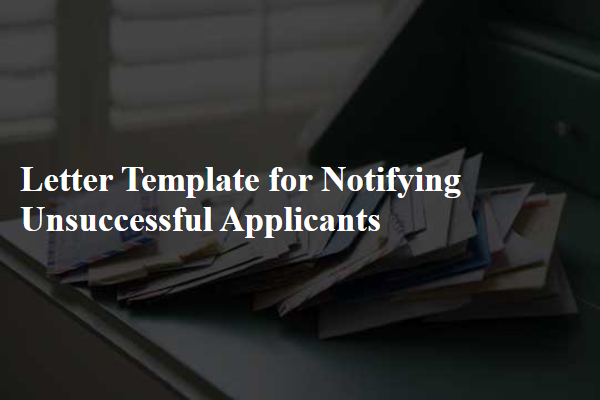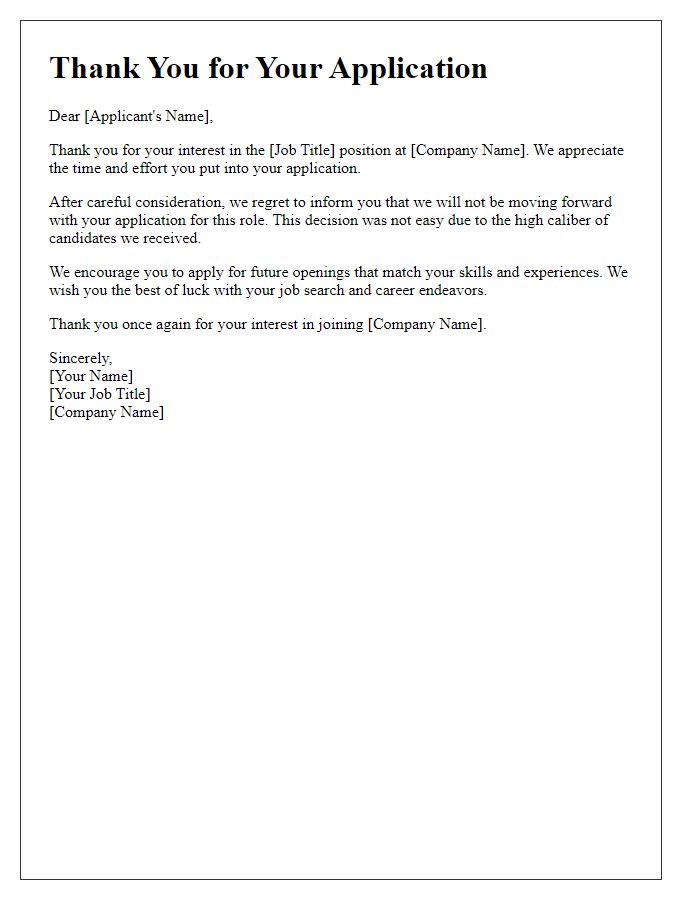When it comes to delivering disappointing news, having the right words can make all the difference. Crafting a letter to notify unsuccessful applicants is a delicate task that requires empathy and clarity, helping them to understand that their efforts were appreciated, even if the outcome wasn't what they hoped for. This communication not only maintains goodwill but also leaves the door open for future opportunities. If you'd like to learn more about how to approach this sensitive matter effectively, keep reading!

Polite and appreciative tone
In a competitive job market, providing feedback to unsuccessful applicants is crucial for maintaining a positive reputation. Organizations often face numerous applications for each position, resulting in many qualified candidates being turned down. Notifying applicants, while challenging, should be done with care. A thoughtful approach involves expressing gratitude for their interest in the company and acknowledging their efforts in the application process. Personalizing the message by highlighting specific strengths observed in the resume or interview can also soften the disappointment. Additionally, offering encouragement for future opportunities and suggesting ways they might further enhance their skills fosters goodwill and leaves the door open for potential future interactions. Such communications not only help applicants feel valued but also reflect positively on the employing organization.
Concise explanation of the decision
A letter template for notifying unsuccessful applicants should include a clear and concise explanation of the decision made by the hiring committee. This communication serves to inform candidates who invested time and effort in the application process that they were not selected for the position. The template should maintain a professional tone while offering constructive feedback, if possible, to help candidates understand the reasons behind the decision. Additionally, it is essential to express appreciation for their interest in the organization and encourage them to apply for future opportunities, reinforcing a positive candidate experience despite the disappointing news.
Invitation for future opportunities
The regretful communication to unsuccessful applicants often serves as an important touchpoint in the recruitment process. Through a carefully crafted email, the organization acknowledges candidates who applied for specific positions, such as Marketing Manager or Software Developer, expressing gratitude for their time and effort. A mention of the competitive nature of the selection process adds context, highlighting that numerous highly qualified candidates vied for each role. Emphasizing the organization's commitment to inclusivity and future growth, this communication invites applicants to consider future openings with a specific guideline, such as signing up for job alerts on the company website. Encouragement to seek new opportunities aligns with fostering a positive relationship with potential talent, promoting future engagement.
Encouragement for feedback or questions
The notification for unsuccessful applicants may evoke feelings of disappointment. Clear communication is essential in maintaining a positive relationship with candidates. The organization can encourage feedback by providing contact details for the HR department, emphasizing a welcoming attitude toward any questions regarding the application process. For instance, the applicant may reach out via email or phone for clarification on why they were not selected or seek advice on improving future applications. This feedback loop fosters a sense of transparency and community. Ultimately, an open dialogue can benefit both parties, promoting a professional network that values growth and opportunity.
Contact details for further queries
Many job applicants may experience disappointment after receiving notification regarding their unsuccessful candidacy in competitive hiring processes. Organizations often send these notifications via email or postal mail, emphasizing that they appreciate the effort put forth by applicants in submitting their qualifications and attending interviews. Such communications typically include contact details, such as the human resources department's phone number (e.g., +1-800-123-4567) or email address (e.g., hr@company.com), to address any further queries or request feedback on performance. This method encourages open dialogue and fosters a positive rapport, leaving candidates with a sense of respect and potential for future opportunities within the organization.













Comments